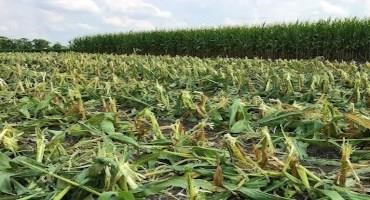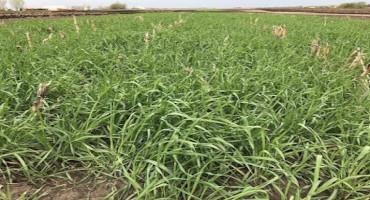By Paul McDivitt
Since sweet corn is harvested as an immature crop, a lot of the nitrogen (N) the crop takes up during the growing season remains in the plant residue left on the surface. Does that N become available to the following crop?
Currently, the University of Minnesota does not recommend taking an N credit for processing sweet corn, grown on over 100,000 acres in the state. However, that may be changing after a new study.
U of M researchers looked at this issue in a three-year study in Waseca, Minnesota from 2017 to 2020. They found an N credit for sweet corn of around 20 pounds of N per acre, 15 pounds less than the N credit following soybean.

Sweet corn harvest
“This means that farmers can potentially save money on nitrogen fertilizer if sweet corn is the previous crop,” said Carl Rosen, lead researcher on the study and a U of M Extension nutrient management specialist. “It's not a huge credit, but if you add it all up, 20 pounds of nitrogen on 100,000 acres is a fair amount of nitrogen.”
The project, funded by Minnesota’s fertilizer check-off dollars through the Agricultural Fertilizer Research and Education Council (AFREC), looked at how field corn performed following four different previous crops: field corn (continuous corn), soybean, sweet corn, and sweet corn followed by a rye cover crop (seeded in late summer after the sweet corn harvest).
Researchers broadcast and incorporated urea just before planting the field corn in the spring at various N rates ranging from zero to 250 pounds per acre. At all N rates, field corn yields were higher following sweet corn and soybean than following field corn. Adding more N fertilizer helped increase yield in continuous field corn but there was still a rotation effect that could not be overcome by adding more N.
In the study, the economic optimum nitrogen rate (EONR), the N rate where you more or less optimize your yield relative to the cost of N fertilizer, was much higher in 2018 and 2019 due to wetter-than-normal conditions compared to the relatively dry 2020 growing season. This is because, in wet years, more N is lost to denitrification and possibly some leaching.
Table 1. Effect of previous crop on EONR and yield at EONR (3-year average)
| Previous crop | EONR | Yield at EONR |
|---|
| Field corn | 228 (lbs N/ac) | 178 (bu/ac) |
| Soybean | 131 | 201 |
| Sweet corn | 146 | 200 |
| Sweet corn + rye | 178 | 207 |
Planting a cover crop after sweet corn harvest
Because sweet corn is harvested earlier in the year than field corn, sweet corn fields are at a higher risk of nitrate leaching in the fall. This makes sweet corn an ideal crop to plant a cover crop after, and an opportunity to protect local water quality.
Planting a cover crop after sweet corn harvest can also help reduce erosion, and, in some cases, help with disease suppression. Winter rye is one of the most popular cover crops in Minnesota because it overwinters and starts growing again in early spring.
According to the study, the rye cover crop following sweet corn reduced residual nitrate in the soil in the fall and the following spring.
“With the cover crop, residual N is lower in the fall and the following spring, and then you terminate the cover crop in the spring and the nitrogen from the cover crop goes back into the soil,” Rosen explained.
Table 2. Effect of previous crop on residual nitrate (0-2 ft depth in fall and spring, averaged over 3 years)
| Previous crop | Fall Nitrate-N | Spring Nitrate-N |
|---|
| Field corn | 34.1 (lbs N/ac) | 51.2 (lbs N/ac) |
| Soybean | 35.7 | 61.6 |
| Sweet corn | 43.2 | 50.9 |
| Sweet corn + rye | 29.3 | 36.8 |
In the first two years of the study, the EONR for field corn following the sweet corn with the rye cover crop was lower than the continuous field corn, meaning the field corn following the sweet corn and rye required less N fertilizer to get the same yield as the continuous corn.
“In general, we didn't need to apply more nitrogen with the cover crop, and in some years you could actually apply less,” Rosen noted. “But if rye is not terminated by May 10th, then a nitrogen credit should not be taken for a previous sweet corn crop.”

Rye cover crop in May
That’s because both the sweet corn residue and the rye residue in the first two years of the study had low carbon-to-nitrogen (C:N) ratios. You want a low C:N ratio for N release from plant residue. A high C:N ratio results in N tie-up in the residue. In the study, sweet corn stover had a C:N ratio of 30-35 while the field corn stover’s C:N ratio was 70-75, so field corn stover is going to tie up a lot more N than sweet corn stover will.
The rye cover crop was planted at the end of August or early September after the sweet corn was harvested in mid-August. Because of adequate moisture conditions, cover crop establishment was good in all three years. Rye biomass was 1,600 pounds per acre in the first year, 1,800 in the second year, and 3,400 in the third year.
“This was kind of the best-case scenario for planting a cover crop,” said Rosen. “Chances of failure are much, much less with a cover crop following sweet corn.”
Cover crop establishment in the study also benefited from wetter-than-normal growing seasons. In dry years, such as the one we are now experiencing in Minnesota, cover crop establishment can be difficult, even following sweet corn, unless there is substantial rainfall after seeding the cover crop. In addition, while the cover crop may take up residual nitrate this fall, if the drought continues through next spring the cover crop could exacerbate water stress on the subsequent field corn crop.
Source : umn.edu